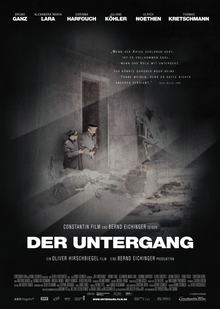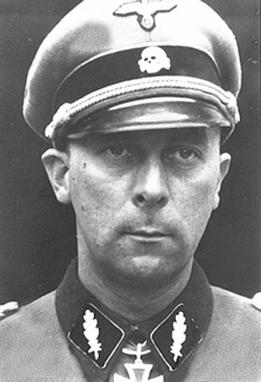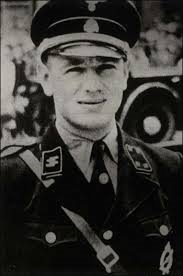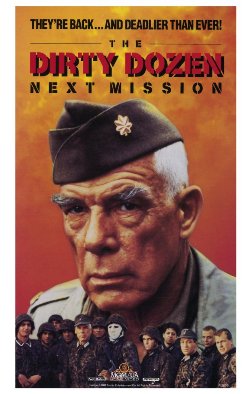
The Schutzstaffel was a major paramilitary organisation under Adolf Hitler and the Nazi Party in Nazi Germany, and later throughout German-occupied Europe during World War II.
The Sturmabteilung was the original paramilitary wing of the Nazi Party. It played a significant role in Adolf Hitler's rise to power in the 1920s and early 1930s. Its primary purposes were providing protection for Nazi rallies and assemblies, disrupting the meetings of opposing parties, fighting against the paramilitary units of the opposing parties, especially the Roter Frontkämpferbund of the Communist Party of Germany (KPD) and the Reichsbanner Schwarz-Rot-Gold of the Social Democratic Party of Germany (SPD), and intimidating Romani, trade unionists, and especially Jews.

The Berghof was Adolf Hitler's holiday home in the Obersalzberg of the Bavarian Alps near Berchtesgaden, Bavaria, Germany. Other than the Wolfsschanze, his headquarters in East Prussia for the invasion of the Soviet Union, he spent more time here than anywhere else during his time as the Führer of Nazi Germany. It was also one of the most widely known of his headquarters, which were located throughout Europe.

Theodor Eicke was a senior SS functionary and Waffen SS divisional commander during the Nazi era. He was one of the key figures in the development of Nazi concentration camps. Eicke served as the second commandant of the Dachau concentration camp from June 1933 to July 1934, and together with his adjutant Michael Lippert, was one of the executioners of SA Chief Ernst Röhm during the Night of the Long Knives purge of 1934. He continued to expand and develop the concentration camp system as the first Concentration Camps Inspector.

Education for Death: The Making of the Nazi is an American animated propaganda short film produced by Walt Disney Productions and released on January 15, 1943, by RKO Radio Pictures, shown in theaters with Fighting Frontier. The film is directed by Clyde Geronimi and principally animated by Milt Kahl, Ward Kimball, Frank Thomas, and Bill Tytla. The short is based on the non-fiction book of the same name by American author Gregor Ziemer. The film features the story of Hans, a boy born and raised in Nazi Germany, his indoctrination in the Hitlerjugend, and his eventual march to war.

The Reich Security Main Office was an organization under Heinrich Himmler in his dual capacity as Chef der Deutschen Polizei and Reichsführer-SS, the head of the Nazi Party's Schutzstaffel (SS). The organization's stated duty was to fight all "enemies of the Reich" inside and outside the borders of Nazi Germany.

The 1st SS Panzer Division Leibstandarte SS Adolf Hitler or SS Division Leibstandarte, abbreviated as LSSAH, began as Adolf Hitler's personal bodyguard unit, responsible for guarding the Führer's person, offices, and residences. Initially the size of a regiment, the LSSAH eventually grew into an elite division-sized unit during World War II.

Downfall is a 2004 historical war drama film written and produced by Bernd Eichinger and directed by Oliver Hirschbiegel. It is set during the Battle of Berlin in World War II, when Nazi Germany is on the verge of total defeat, and depicts the final days of Adolf Hitler. The cast includes Alexandra Maria Lara, Corinna Harfouch, Ulrich Matthes, Juliane Köhler, Heino Ferch, Christian Berkel, Alexander Held, Matthias Habich, and Thomas Kretschmann. The film is a German-Austrian-Italian co-production.

Adolf Hitler, chancellor and dictator of Nazi Germany from 1933 to 1945, committed suicide via a gunshot to the head on 30 April 1945 in the Führerbunker in Berlin after it became clear that Germany would lose the Battle of Berlin, which led to the end of World War II in Europe. Eva Braun, his wife of one day, also committed suicide by cyanide poisoning. In accordance with Hitler's prior written and verbal instructions, that afternoon their remains were carried up the stairs and through the bunker's emergency exit to the Reich Chancellery garden, where they were doused in petrol and burned. The news of Hitler's death was announced on German radio the next day, 1 May.

Adolf Hitler, dictator of Germany from 1933 to 1945, has been represented in popular culture ever since he became a well-known politician in Germany. His distinctive image was often parodied by his opponents. Parodies became much more prominent outside Germany during his period in power. Since the end of World War II representations of Hitler, both serious and satirical, have continued to be prominent in popular culture, sometimes generating significant controversy. In many periodicals, books, and movies, Hitler and Nazism fulfill the role of archetypal evil. This treatment is not confined to fiction but is widespread amongst nonfiction writers who have discussed him in this vein. Hitler has retained a fascination from other perspectives; among many comparable examples is an exhibition at the German Historical Museum which was widely attended.
SS-Verfügungstruppe was formed in 1934 as combat troops for the Nazi Party (NSDAP). On 17 August 1938 Adolf Hitler decreed that the SS-VT was neither a part of the Ordnungspolizei nor the Wehrmacht, but military-trained men at the disposal of the Führer. In time of war, the SS-VT were to be placed at the disposal of the army.

Julius Schreck was an early senior Nazi official and close confidant of Adolf Hitler.

Wilhelm Mohnke was a German military officer who was one of the original members of the SchutzstaffelSS-Stabswache Berlin formed in March 1933. Mohnke, who had joined the Nazi Party in September 1931, rose through the ranks to become one of Adolf Hitler's last remaining general officers at the end of World War II in Europe.

Hitler's SS: Portrait in Evil is a 1985 American made-for-television war drama film about two German brothers, Helmut and Karl Hoffmann, and the paths they take during the Nazi regime. The movie was directed by Jim Goddard and starred John Shea, Bill Nighy, Tony Randall, David Warner and John Woodnutt. The film shows Karl, who was originally enthusiastic about the Nazi Party, becoming disillusioned and Helmut, who was at first wary of the Nazi Party, joining the Schutzstaffel (SS) and later being an accomplice to war crimes.

Ernst-Günther Schenck was a German medical doctor and member of the SS in Nazi Germany. Because of a chance encounter with Adolf Hitler during the closing days of World War II, his memoirs proved historically valuable. His accounts of this period are prominent in the works of Joachim Fest and James P. O'Donnell regarding the end of Hitler's life, and were included in the film Downfall (2004).

Erich Kempka was a member of the SS in Nazi Germany who served as Adolf Hitler's primary chauffeur from 1936 to April 1945. He was present in the area of the Reich Chancellery on 30 April 1945, when Hitler shot himself in the Führerbunker. Kempka delivered petrol to the garden behind the Chancellery, where the remains of Hitler and Eva Braun were burned. After Kempka's capture by United States forces, he served as an eyewitness as to Hitler's demise, albeit his self-admitted unreliability.

The Dirty Dozen: Next Mission is a 1985 made-for-TV film and sequel to the original 1967 film Dirty Dozen, directed by Andrew V. McLaglen and reuniting Lee Marvin, Ernest Borgnine and Richard Jaeckel 18 years after the original hit war film. Marvin returns to lead an all-new dirty dozen on a mission to assassinate SS General Sepp Dietrich, played by Wolf Kahler.

Hitler – Dead or Alive is a 1942 American propaganda war film directed by Nick Grinde. The plot of Hitler – Dead or Alive was inspired by true events but takes a quasi-comic tone.

Various organisations in Nazi Germany required their members to swear oaths to Adolf Hitler by name, rather than to the German state or an officeholder. Such oaths were intended to increase personal loyalty to Hitler and prevent dissent. The Hitler oath, introduced for all members of the Wehrmacht and civil servants in 1934, was one such oath. Others were sworn by members of organisations such as the Schutzstaffel (SS), whose oath may have inspired the Hitler oath, and by the Hitler Youth.

















